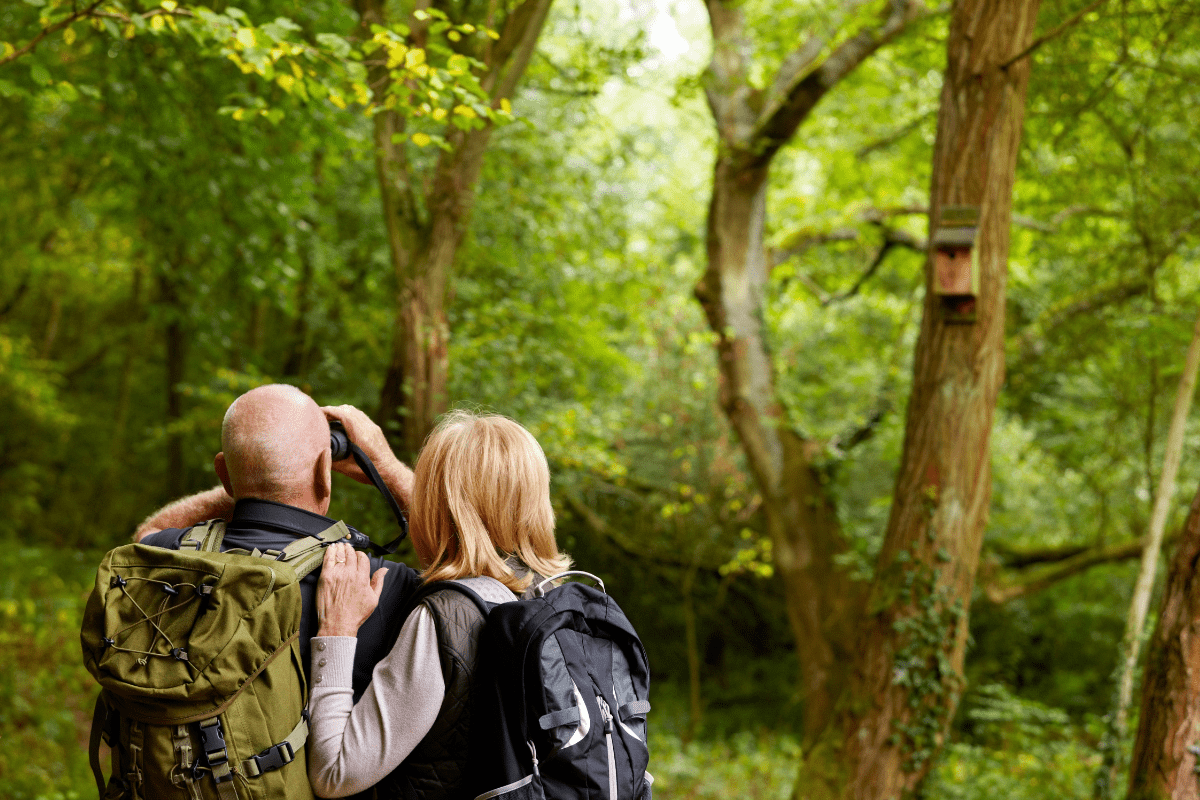Let me tell you a secret about Indiana: we've got 30,000 sandhill cranes that throw the wildest parties every November, and you're invited. Sure, people think of corn and racing when they hear "Indiana," but with over 750 wildlife species calling this state home, we're basically the Midwest's version of a nature documentary… just with more soybeans in the background.
Getting geared up without going broke
Before you rush off to see those party-loving cranes, let's talk about what you actually need versus what the outdoor stores will try to convince you need. Trust me, I've been there, standing in the binocular aisle wondering if I really need the $2,000 pair that can probably see into the future.
Here's the truth: you need decent binoculars, weather-appropriate clothes that won't scare away every animal within a mile radius, and maybe a field guide so you're not calling every brown bird a "sparrow thingy." The Celestron Nature DX 8×42 binoculars run about $180-220 and are waterproof, which matters when you're standing in an Indiana field during our famously unpredictable weather. If you've got deeper pockets, the Vortex Viper HD at $480-640 will make you feel like a professional naturalist, especially if you wear glasses since they've got that nice 20mm eye relief.
For photographers, here's where it gets expensive. You'll want a 400-600mm lens for birds doing their thing in flight, or 200-400mm if you're focusing on bigger critters like deer who move at approximately the speed of a government office. Set your camera to shutter priority at 1/1600 second or faster, bump that ISO to 800-1600, and remember… always focus on the eyes. Nothing ruins a wildlife photo faster than a blurry-eyed bird that looks like it just woke up from a rough night.
What to wear when you're trying not to look like a neon warning sign
Indiana weather is like that friend who can't decide what restaurant to go to. One minute it's sunny, the next you're in a downpour. Layer up with moisture-wicking base layers, throw on some earth-tone outer clothes (think "fashionable tree"), and always bring a waterproof shell.
From May through July, ticks become your unwanted hiking buddies. These little vampires are particularly fond of southern Indiana, so here's your battle plan:
- Treat clothes with permethrin
- Apply DEET to exposed skin
- Tuck pants into socks (fashion be damned)
- Shower within two hours post-hike
- Wash clothes in hot water
- Dry on high heat for an hour
- Check everywhere… and I mean everywhere
- Repeat paranoid checking three hours later
Where to see Indiana's wildlife superstars
Let's start with the main event that makes Indiana famous in wildlife circles, even if most Hoosiers don't know it.
Jasper-Pulaski Fish & Wildlife Area: crane central
Located at 5822 Fish and Wildlife Lane in Medaryville, Jasper-Pulaski hosts the largest sandhill crane gathering east of the Mississippi. We're talking 20,000 to 30,000 of these prehistoric-looking birds all hanging out like it's Woodstock for cranes.
The observation platform is ADA-accessible and has mounted spotting scopes, which is perfect because these birds are basically doing synchronized aerial ballet at sunrise and sunset. Show up at least an hour before sunrise if you want the full experience… yes, I know that's painfully early, but trust me, watching thousands of cranes lift off while making their haunting calls is better than coffee for waking you up.
DNR biologists count the cranes every Tuesday during migration season, and in December 2024, they reported over 20,000 birds. Peak viewing runs from mid-October through mid-December, with Thanksgiving week usually being absolute crane chaos in the best possible way.
Muscatatuck National Wildlife Refuge: the overachiever
Near Seymour, Muscatatuck National Wildlife Refuge is that student who does extra credit for fun. This 7,724-acre refuge has documented over 280 bird species, resident bald eagles, wintering trumpeter swans, and successfully reintroduced river otters who are living their best lives.
The four-mile auto tour is perfect for those days when you want to wildlife watch but also stay in your heated car (no judgment here). The Chestnut Ridge Interpretive Trail is a quarter-mile, wheelchair-accessible path that makes everyone feel like a successful naturalist. During winter, up to 30,000 sandhill cranes roost in the wetlands, apparently following their buddies from Jasper-Pulaski for the after-party.
Spring brings waves of migrating warblers, including the prothonotary warbler, which sounds like a church official but is actually a brilliant golden bird that makes other birds look underdressed.
Indiana Dunes National Park: the migration superhighway
Indiana Dunes is where 350 documented bird species have been spotted, making it the Midwest's equivalent of LAX for migrating birds. The diverse habitats create a funnel effect along Lake Michigan's shore, concentrating birds during spring and fall migrations.
West Beach's Long Lake attracts diving ducks and waterfowl, while the Beverly Shores Great Marsh loop road offers drive-through wildlife viewing… like a safari, but with more Canada geese and fewer lions. During May's peak warbler migration, you can spot 35 species in a single morning, which sounds impossible until you're there with your binoculars, frantically trying to identify that yellow blur that just zoomed past.
The park also hosts the federally endangered Karner blue butterfly, which depends on wild lupine and has very specific real estate requirements. They're basically the house hunters of the butterfly world: "I need wild lupine, oak savanna habitat, and good schools for the caterpillars."
Indiana's greatest comeback stories
Sometimes nature needs a little help from its human friends, and Indiana has some success stories that'll restore your faith in conservation.
The bald eagle resurrection
In the 1980s, Indiana's bald eagles were basically extinct, victims of DDT and habitat loss. But between 1985 and 1989, wildlife biologists played matchmaker by bringing in 73 eaglets from Wisconsin and Alaska. As John Castrale, DNR Nongame Bird Biologist, notes, "About a third of those eagles survived to establish breeding territories."
Fast forward to today: Indiana boasts approximately 350 nesting territories across 88 of our 92 counties. The eagles were officially removed from the endangered list in 2024, proving that sometimes government programs actually work (shocking, I know).
Winter eagle viewing peaks in January and February when birds concentrate near open water below dams. Lake Monroe hosts an annual Eagle Watch Weekend, while the Mississinewa River near Peru and White River through central Indiana offer reliable viewing. Just remember to maintain at least 330 feet distance… that's about a football field, for those of us who measure everything in sports references.
The hellbender comeback nobody saw coming
Eastern hellbender salamanders sound like a heavy metal band but are actually two-foot-long salamanders that nearly vanished from Indiana waters. Since 2017, over 800 young hellbenders raised in zoos have been released into the Blue River system.
"Indiana has become a leader in hellbender research and conservation in the Midwest," says DNR herpetologist Nate Engbrecht. In 2023, biologists found the first wild-born hellbender larva in the Blue River in over three decades. While you probably won't see one (they're still rare and prefer hiding under rocks like introverted teenagers), their presence indicates our water quality is improving.
The mysterious case of the Florida birds in Indiana
Here's where things get weird. The limpkin, a tropical wading bird that should be sipping mojitos in Florida, decided Indiana looked nice in 2022. Aidan Rominger reported the state's first limpkin from his kayak at Crooked Creek State Recreation Area in June 2022, probably after doing a double-take and checking his bird guide seventeen times.
Since then, there have been 694 total sightings across 30 locations in 24 counties. As Jason Jablonski observed, "Whether it is a lack of food sources in the far south or a change in the climate, there is something going on that has caused such a dramatic location shift for this species." The birds make a distinctive "kweeear" call that sounds like a crying banshee, making them easier to locate than your keys when you're late for work.
Hidden gems for the adventurous viewer
Not every great wildlife spot makes it into the tourist brochures. Some of Indiana's best viewing happens in places you've probably driven past a hundred times.
County parks deliver surprising wildlife diversity without the crowds. Campbell-Woodland Nature Trails near New Albany combines 122 acres of mixed habitats with accessible boardwalks where warblers, deer, and creek wildlife thrive. The newly opened Buttonbush Woods Mill Creek Trail is so fresh it hasn't even made it to Google Maps yet, featuring 0.7 miles through "wet woods" where beaver, turkey, and migratory birds hang out like it's their private club.
Specialized wildlife experiences
Kankakee Sands puts on a different kind of show with its 8,400-acre prairie restoration supporting over 240 bird species. Oh, and bison. Yes, actual bison in Indiana, viewable through provided scopes from 7 AM to dusk because apparently, bison don't respect your sleep schedule either.
For something magical, Indiana's 43 firefly species peak from early May through mid-July. The New Harmony Firefly Festival offers guided tram tours to premium viewing areas, because yes, firefly watching is a thing, and it's absolutely worth staying up past your bedtime for.
Urban locations provide unexpected wildlife encounters too. Eagle Creek Park in Indianapolis is one of the largest city parks in the US, while Fort Harrison State Park hosts yellow-breasted chats and Henslow's sparrows within city limits. Who needs to drive hours when the wildlife comes to you?
Timing your wildlife adventure
Wildlife operates on its own schedule, completely ignoring your vacation days and weekend plans. Here's when to catch the best shows:
Spring warbler migration peaks in early May when you can spot 35+ species in a single morning at Indiana Dunes. It's like nature's version of speed dating, but with more colorful outfits and better singing.
Sandhill cranes follow a predictable schedule: arriving mid-October, peaking around Thanksgiving (because even cranes appreciate tradition), and departing by mid-December. Winter concentrates bald eagles near open water below dams from November through March, with peak viewing during the January-February ice breakup when eagles apparently get cabin fever too.
Weather as your wildlife viewing assistant
Morning fog along rivers creates atmospheric conditions that make photographers weep with joy while concentrating waterfowl in visible locations. Cold fronts trigger migration waves, so the day after a front passes is ideal for spotting new arrivals. Heavy rains temporarily flood fields, creating impromptu shorebird habitat in places that normally just grow corn.
Getting involved beyond watching
Watching wildlife is great, but helping conserve it feels even better. The Indiana Master Naturalist Program offers seasonal programs that'll turn you from a casual observer into someone who actually knows what they're looking at.
Citizen science programs multiply your impact while giving you insider knowledge of wildlife locations. Christmas Bird Count traditions continue across multiple count circles, while eBird submissions help track populations and alert other birders to unusual sightings. Summer bat roost monitoring needs volunteers for 8-12 survey nights between mid-May and mid-July, perfect for night owls who want their insomnia to count for something.
The bottom line on ethical viewing
Here's the thing about wildlife: they didn't sign up to be Instagram stars. If an animal changes its behavior, you're too close. Period. Use those expensive optics you bought instead of trying to get close enough for a phone selfie with a bald eagle (minimum distance: 330 feet, seriously).
Never use flash photography on wildlife… it's like someone shining a spotlight in your face at 3 AM. Don't disturb nests, don't damage habitat for a better angle, and definitely don't feed wildlife. They're not your pets, and you're not their DoorDash driver.
Your wildlife viewing starter pack
Ready to join Indiana's wildlife watching community? Grab some decent binoculars, dress like a tree, and head to Jasper-Pulaski during crane season. Check Indiana Birding Trail for locations near you, download eBird to track your sightings, and remember: the best wildlife viewing happens when you're patient, quiet, and slightly uncomfortable from waking up too early.
Indiana's wildlife won't win any awards for being exotic, but watching 30,000 sandhill cranes take flight at sunrise or spotting your first bald eagle fishing the White River? That's the kind of experience that turns casual observers into lifelong conservationists. Plus, it's way cheaper than that African safari you've been dreaming about, and you can be home in time for dinner.





